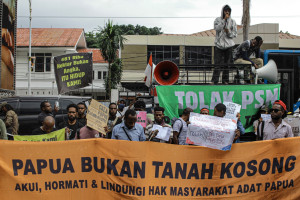Unbelievable Threat: Indonesia's Food and Energy Project Could Devastate Native Lands!

Imagine waking up one day to find your home turned into a massive agricultural estate—this is the reality facing indigenous communities in Southern Papua as the government embarks on its controversial Food and Energy Estate project.
With plans to clear vast areas of land in Merauke, Mappi, and Boven Digoel, this initiative has sparked a firestorm of criticism due to its potential environmental destruction and the adverse effects on local indigenous peoples. It’s not just about farming; it’s about the very survival of communities that have thrived in harmony with their forested surroundings for generations.
The ambitious plan, which falls under Indonesia’s National Strategic Projects (PSN), is set to transform nearly 1 million hectares into rice plantations, livestock farms, and bioethanol-producing sugarcane fields. It’s a colossal project that threatens to impact over 543,575 hectares of forest, endangering not just trees but the livelihoods and cultural identities of countless individuals.
Backed by Minister of Forestry Decrees No. 430/2025 and No. 591/2025, this project allows significant shifts in land use, paving the way for what many see as a catastrophic loss of biodiversity and indigenous rights. According to environmental advocates, we’re looking at up to 695,315 hectares of forest being at risk, an alarming figure that highlights the urgency of the situation.
Critics have been vocal about the project, with Uli Arta Siagian from WALHI labeling it as “colonial” and a blatant crime against nature and indigenous rights. Amalya Reza, a Bioenergy Campaigner at Trend Asia, emphasized the hypocrisy of a government that claims to support forest restoration while actively engaging in actions that lead to its destruction. “This is a failure repeating itself,” she stated, shedding light on the cyclical pattern of environmental degradation.
The indigenous communities in Merauke, Asmat, Boven Digoel, and Mappi are at the heart of this struggle, as their survival is deeply tied to the forests. The sago palms and wildlife that provide food are now under threat, with 49 indigenous areas facing displacement due to the project. It’s a heartbreaking scenario that highlights the ongoing battle for land and rights.
Moreover, critics argue that the project reflects a broader strategy to consolidate state control over forest and land resources, dismissing these lands as “empty” and ripe for exploitation. Sutami from Pusaka Bentala Rakyat condemned these assertions, calling them illegal and an attempt to uproot generations of indigenous families from their ancestral lands.
This ambitious undertaking poses severe implications not only for the environment but also for the very fabric of indigenous cultures, raising important questions about the balance between development and conservation in Papua.

















